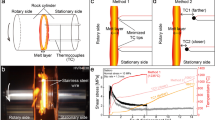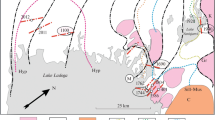Abstract
Friction rocks are produced by concentrated shear and partial melting at the Earth surface. Although the commonest examples are known from earthquake-generated layers (pseudotachylytes), such rocks may also derive from the slippage of rock avalanches. While numerous studies have been dedicated to earthquake-generated pseudotachylytes from a petrological, geochemical and physical viewpoint, fewer investigations have focused on the corresponding rock avalanche rocks (also termed frictionites), especially concerning the mechanics of formation and its relationship to the mineralogical composition of the original rock. In this work, we introduce a numerical model for the melting of a crystalline micro-breccia (gouge) in the shear layer of a rock avalanche due to heat generated at the sliding surface. The motion of the landslide is calculated and the resulting frictional heat is used to compute the melting of the crystalline gouge. We constrain the model based on calibration of the Köfels frictionite in Austria, the best-known example of landslide-frictionite association. We have collected samples of frictionite and of the original rock consisting of gneiss rich in alkaline feldspar and have analysed it chemically and mineralogically. Not only should the model calculate the temperature increase to fuse the average gneissic rock, we also require that the simulated percentages of mineral species should reasonably reproduce the data. The compositional data of both the original rock and the frictionite, whose mineralogical species have different melting temperatures, latent heats and thermal conductivities, allow us to constrain the numerical simulations. A second aspect considered in this work is the particular pumiceous texture derived from growth and coalescence of bubbles as a consequence of decreasing ambient pressure. The simulations show a satisfactory agreement with data but also discrepancies that are probably due to the limitations of the numerical model and to the irregular grain shape of the rock gouge in the real data. Simulations indicate that although temperatures were higher than the melting temperature of all the species, complete melting of the original crystals was not reached because of the limited duration of the landslide flow. The model could be of interest for future quantitative investigations of landslide frictionites.










Similar content being viewed by others
References
Alexiades CA, Jackson ML (1967) Chlorite determination in clays of soils and mineral deposits. Am Mineral 52:1855–1873
Billi A (2005) Grain size distribution and thickness of breccias and gouge zones from thin (<1 m) strike-slip fault cores in limestone. J Struct Geol 27:1823–1837
De Blasio FV (2007) Production of frictional heat and hot vapour in a model of self-lubricating landslides. Rock Mech Rock Eng 41:219–226
De Blasio FV (2011) Introduction to the physics of landslides. Springer, Berlin, 408 pp
De Blasio FV, Elverhøi A (2008) A model for frictional melt production beneath large rock avalanches. J Geophys Res 113, F02014. doi:10.1029/2007JF000867, ISSN 0148-0227
Di Toro G, Goldsby DL, Tullis TE (2004) Friction falls to towards zero in quartz rock as slip velocity approaches seismic rates. Nature 427:436–439
Erismann TH (1979) Mechanisms of large landslides. Rock Mech Rock Eng 12:5–46
Erismann TH, Abele G (2001) Dynamics of rockslides and rockfalls. Springer, Berlin
Fialko Y, Khazan Y (2005) Melting by earthquake fault friction: stick or slip? J Geophys Res 110:B12407
Goguel J (1978) Scale-dependent rockslide mechanisms, with emphasis on the role of pore fluid vaporization. In: Voight B (ed) Rockslides and avalanches. Elsevier, Amsterdam, pp 693–706
Goren L, Aharonov E (2007) Long runout landslides: the role of frictional heating and hydraulic diffusivity. Geophys Res Lett 34:L07301
Habib P (1975) Production of gaseous pore pressure during rock slides. Rock Mech Rock Eng 7:193–197
Hermanns RL, Blikra LH, Naumann M, Nielsen B, Panthi KK, Stromeyer D, Longva O (2006) Examples of multiple rock-slope collapses from Köfels (Otz Valley, Austria) and western Norway. Eng Geol 83:94–108
Heuberger H (1994) The giant landslide of Köfels, Ötztal, Tyrol. Mt Res Dev 14(994):290–294
Holland TJB, Redfern SAT (1997) Unit cell refinement from powder diffraction data: the use of regression diagnostics. Mineral Mag 61:65–77
Ivy-Ochs S, Heuberger H, Kubik PW, Kerschner H, Bonani G, Frank M, Schlüchter C (1998) The age of the Köfels event. Relative, 14C and cosmogenic isotope dating of an early Holocene landslide in the central Alps (Tyrol, Austria). Z Gletscherk Glazialgeol 34:57–70
Larson AC, Von Dreele RB (2000) General structure analysis system (GSAS). Los Alamos National Laboratory Report LAUR 86–748
Legros F (2002) The mobility of long-runout landslides. Eng Geol 63:301–331
Legros F, Cantagrel J-M, Devouard B (2000) Pseudotachylyte (frictionite) at the base of the Arequipa volcanic landslide deposit (Peru): implications for emplacement mechanisms. J Geol 108:601–611
Lin A, Chen A, Liau C-F, Lee C-T, Lin C-C, Lin P-S, Wen S-C, Ouchi T (2001) Frictional melting due to coseismic landsliding during the 1999 Chi-Chi (Taiwan) M 7.3 earthquake. Geophys Res Lett 28:4011–4014
MacKenzie JD (1960) Melting of quartz and cristobalite. J Am Ceram Soc 43(12):615–619
Magloughlin JF, Spray JG (1992) Frictional melting processes and production in geological materials: introduction and discussion. Tectonophysics 204:197–206
Masch L, Wenk HR, Preuss E (1985) Electron microscopy study of hyalomilonites: evidence for frictional melting in landslides. Tectonophysics 115:131–160
Parfitt EA, Wilson L (2008) Fundamentals of physical volcanology. Wiley-Blackwell, Hoboken, 252 pp
Prager C, Zangerl C, Nagler T (2009) Geological controls on slope deformations in the Köfels Rockslide area (Tyrol, Austria). Aust J Earth Sci 102:4–19
Preuss E (1971) Über den Bimsstein von Köfels/Tirol. Fortschr Mineral 49:70
Proussevitch AA, Sahagian DL (1998) Dynamics and energetics of bubble growth in magmas: analytical formulation and numerical modeling. J Geophys Res 103:18223–18251
Rietveld HM (1969) A profile refinement method for nuclear and magnetic structures. J Appl Crystallogr 2:65–71
Scheidegger AE (1973) On the prediction of the release and velocity of catastrophic rockfalls. Rock Mech 5(4):231–236
Scholz CH (2002) The mechanics of earthquakes and faulting, 2nd edn. Cambridge University Press, Cambridge
Sirono S, Satomi K, Watanabe S (2006) Numerical simulations of frictional melting: small dependence of shear stress drop on viscosity parameters. J Geophys Res 111:B06309
Somerton WH (1992) Thermal properties and temperature-related behaviour of rock/fluid systems. Elsevier, Amsterdam
Sørensen S-A, Bauer B (2003) On the dynamics of the Köfels sturzstrom. Geomorphology 54:11–19
Spera FJ (2000) Physical properties of magmas. In: Sigurdsson H, Houghton B, Rymer H, Stix J (eds) Encyclopaedia of volcanoes. Academic, New York, pp 171–190
Spray J (2005) Pseudotachylyte controversy: fact or friction? Geology 23:1119–1122
Suess FE (1937) Der Meteor-Krater von Köfels bei Umhausen im Ötztale, Tirol. Neues Jahrb Mineral Geol Paläontol Abh 72:98–155
Surenian RS (1988) Scanning electron microscope study of shock features in pumice and gneiss from Köfels (Tyrol, Austria). Mitt Geol Paläontol Innsbruck 15:135–143
Toby BH (2001) EXPGUI, a graphical interface for GSAS. J Appl Crystallogr 34:210–213
Toramaru A (1989) Vesiculation process and bubble size distributions in ascending magmas with constant velocities. J Geophys Res 94:17523–17542
Vardoulakis I (2000) Catastrophic landslides due to frictional heating of the failure plane. Mech Cohes Frict Mater 5:443–467
Weidinger JT, Korup O (2009) Frictionite as evidence from a Late Quaternary rockslide near Kanchenjunga, Sikkim Himalayas, India—implications for extreme events in mountain relief destruction. Geomorphology 103:57–65
Weidinger JT, Korup O, Munack H, Altenberger U, Dunning SA, Tippelt G, Lottermoser W (2014) Giant rockslides from the inside. Earth Planet Sci Lett 389:62–73
Wenk HR (1978) Are pseudotachylites product of fracture or melting? Geology 6:507–511
Yamada K, Emori H, Nakazawa K (2008) Time-evolution of bubble formation in a viscous fluid. Earth Planets Space 60:661–679
Acknowledgments
We would like to thank Prof. Ermanno Galli (University of Modena and Reggio Emilia) for the selection of single crystals, Dr. Antonio Lettino (National Research Council of Italy—IMAA) for assistance with the thin sections and Marco Moresco for the help with some of the photographs. The paper benefitted from in-depth review of some anonymous referees.
Author information
Authors and Affiliations
Corresponding author
Appendices
Appendix 1: Analytical calculation of the velocity for an exponential profile of the topography
The velocity of the centre of mass in a lumped mass model in which the centre of mass of the landslide is represented by a point moving along the terrain is calculated analytically for the case of an exponential-like topography of the form y = y 0 e − Λx.
Because \( \frac{\mathrm{d}U}{\mathrm{d}t}=\frac{\mathrm{d}U}{\mathrm{d}l}\frac{\mathrm{d}l}{\mathrm{d}t}=\frac{U\mathrm{d}U}{\mathrm{d}l}=\frac{1}{2}\frac{\mathrm{d}{U}^2}{\mathrm{d}l} \) where dl is the path length, and using the equation of motion (1), we find
from which, considering that sin β dl = dy = (dy/dx)dx and that cos β dl = dx, it follows by direct integration that the velocity as a function of the horizontal coordinate is
Note that after a certain distance, the term tanϕ x prevails in the argument of the square root of Eq. (17), and thus, the velocity starts to decrease. This is noticeable in Fig. 6a for the case of highest friction coefficients for x > 1300 m.
After a distance x 1 a linear topography with inclination β ′ is assumed. The velocity for x > x 1 can be calculated as
where \( {U}_1=\sqrt{2g\left[{y}_0\left(1-{e}^{-\varLambda {x}_1}\right)- \tan \kern0.1em \phi \kern0.28em {x}_1\right]} \) is the velocity at the transition point x1. The values adopted here for the Köfels landslide are y 0 = 600 m, Λ− 1 = 1250 m, x 1 = 1250 m, x 1 = 2000 m and β ′ = −12°.
Appendix 2: Calculation of frictional heat and temperature increase for constant slope topography
Although the calculation of frictional heat production and temperature underneath a landslide requires a numerical computation, it is useful to provide an analytical solution based on simplified assumptions. In the following, the slab slides at constant slope angle β and latent heat effects due to the re-crystallization of the mineral phases are neglected. The temperature inside the computational cell of thickness δ corresponding to the shear layer underneath the slab thus varies with Eq. (4) without the latent heat term
where the first and last terms on the right-hand side are the energy generated by friction and the energy diffused out of the cell, respectively.
Because
and considering that the velocity along slope increases in time as
we find the differential equation
where
The solution of Eq. (22) is
where the initial temperature is equal to the external temperature, T S(0) = T EXT.
For short times (t ≪ Ω− 1), the solution Eq. (24) reduces to
Considering that Ω− 1 ≈ 100–300 s, the limit (25) will be valid during a long part of the initial landslide flow. Keeping only the first two terms of Eq. (25) and using the expression for the velocity (21) gives also
which compares with the estimate given by Sørensen and Bauer (2003), who for simplicity set the square bracket in (26) to 1. Note that the first two terms in Eq. (25) do not contain the effect of heat diffusion out of the cell, as only the third does. Moreover, if δ is assumed to increase with the diffusing heat front rather than being constant, the temperature would increase as t 3/2 (De Blasio 2007). For completeness, we provide also the opposite limit for the temperature (t ≫ Ω− 1) in which
Substitution of time as a function of the path L (i.e. the distance covered along the terrain) in Eq. (24) \( t=\sqrt{2L/\left[\mathrm{g}\left( \sin \beta - \tan \phi \kern0.2em \cos \beta \right)\right]} \) gives also the temperature as a function of L.
Rights and permissions
About this article
Cite this article
De Blasio, F.V., Medici, L. Microscopic model of rock melting beneath landslides calibrated on the mineralogical analysis of the Köfels frictionite. Landslides 14, 337–350 (2017). https://doi.org/10.1007/s10346-016-0700-z
Received:
Accepted:
Published:
Issue Date:
DOI: https://doi.org/10.1007/s10346-016-0700-z




